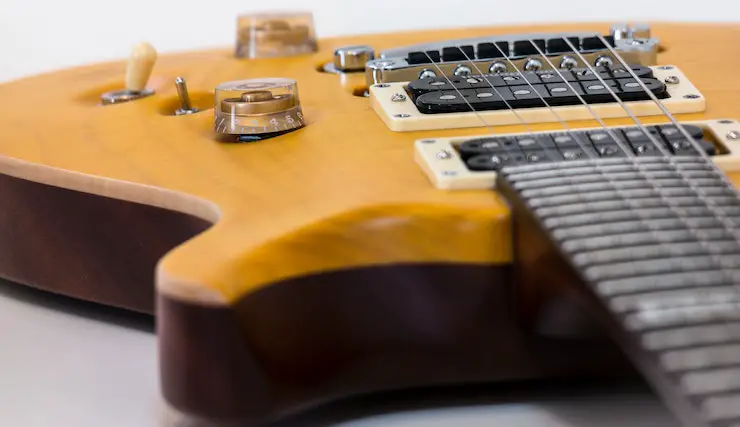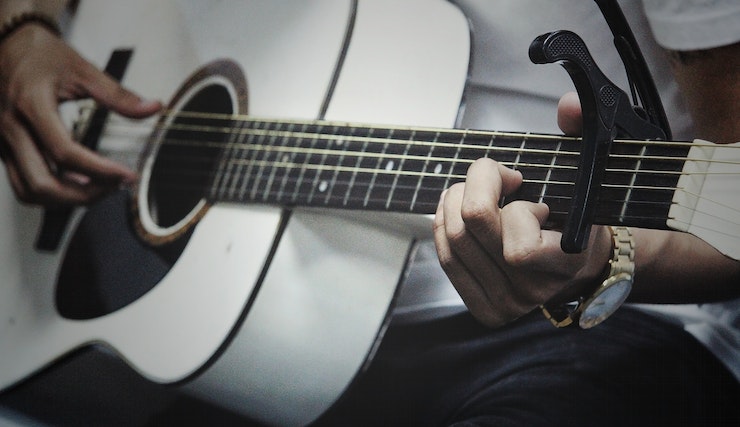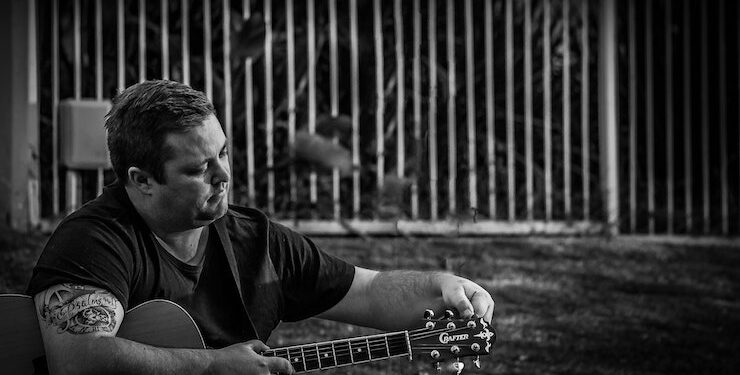Is Drop G Tuning Six Strings?
Drop G tuning refers to a kind of guitar tuning in which the string with the lowest pitch, usually the sixth string, is tuned in G rather than its normal tuning of E. With this tune, it is tuned in the following manner: G-D-G-C-FF-A. The reason for Drop G tuning is to produce the sound of a heavier and lower pitch, which is particularly appropriate for heavy metal and any other music genres that need a dark and more aggressive sound. By lowering the sixth fret to G, the guitarist can play power chords using one finger across the entire string, making it simpler to play massive and dissonant-sounding riffs.
This tuning is very popular with guitarists looking to create the sound of a crushing and deep bass without the need to tune down the entire guitar. It’s worth noting that dropping G tuning could necessitate adjustments to the guitar’s setup, including the gauge and intonation, to adjust to the lower tension while maintaining the proper playing ability. It is always recommended to speak with a professional guitar tech if you’re thinking about dropping G tuning to ensure that your guitar is configured and to prevent any damage or problems.
Do You Know How To Write The Sixth String So That It Ends In G?

Tuning a standard guitar to drop G requires tuning it to a lower pitch by tuning the sixth string downward from G to E. Here’s a full description of the procedure:
Begin with the Standard Tuning
Start with the guitar in regular tuning. The strings are tuned to E-A-D-G-B-E, starting from the lowest to the highest string tuning scales.
Tune the First Five Strings
Ensure the initial five strings (from the 6th through the second) are unaltered in their standard tuning. The strings will be the same in regular tuning, so your chord patterns and scales, as you know, are useful.
Tune the Sixth String to G
To attain drop G tuning To achieve drop G tuning, the sixth string has to be tuned by a degree from E down to G. To achieve this, you must follow these steps:
- Use the guitar’s tuner as a reference pitch to guarantee accuracy.
- Begin fretting on the fourth fret of the sixth string (the E string) and then play the open fifth string (the fifth A string).
- Adjust the tuning pin on the sixth string so that the pitch matches that of the fifth string.
- You have successfully set the 6th string drop to G when they are together.
Check and Adjust Intonation
After you have tuned your strings until they drop to G, testing and adjusting your guitar’s tonality are essential. It refers to the precision of the pitch of the different frets on the neck. Use a guitar tuner to check that pitch on the 12th fret on each string of the harmonic at the same point. If there are differences, there may be a need for adjustments. Talk to a professional guitar technician to make any necessary adjustments to the intonation to ensure that you are playing properly.
Consider String Gauge and Tension
Drop G tuning results in an important reduction in string tension, particularly on the 6th. The decreased tension could cause certain guitars to suffer from fret buzzing or issues with intonation. To avoid these issues, it is recommended to choose larger-gauge strings that can handle lower pitches and keep the proper tension. Guitar technicians can help you decide on the best string and adjust your guitar’s setup to ensure the best playing performance.
It is important to remember that tuning an instrument to drop G could affect the setup of the guitar and its overall playing ability. A consultation with a professional guitar tech is recommended to ensure your guitar is set up to tune for drop G and prevent any damage or problems.
Which Tuning Is The Open One On A Six-String Guitar?

G tuning is open. G tuning on a 6-string guitar entails tuning the strings to make a G major chord when strumming with no finger position on the fretboard. This is a thorough overview of how to open G Tuning:
Begin with the Standard Tuning
Start with the guitar in normal tuning. The strings are usually tuned to E-A-D-G-B-E, starting from the lowest string.
Tune the First Five Strings
The primary five strings (from the 6th string to the 2nd string) are adjusted to certain pitches to attain open G tuning. The steps to follow are:
- Tune the 6th string (low E) down a full move to the D.
- Tune the 5th string (A) down a full one step until G.
- Keep that 4th fret (D) unaltered in its regular tuning.
- Tune the 3rd String (G) down one move to F.
- Tune the 2nd string (B) down a one-quarter step, then A.
Tune the Sixth String to D
The string (lower E) can be tuned one level to D. You can use an instrument tuner or reference pitch to guarantee accuracy. Set the peg of tuning on this string to ensure it is in tune with the pitch of the D note.
Tune the Fifth String to G
The fifth string (A) is tuned down one level to G. Utilize an instrument tuning device or refer to pitch to match the note of the G note.
Tune the Third String to G
The third String (G) is tuned down to one number of steps to F. Utilize an instrument or reference pitch to set the third string according to the frequency of the F note. Tune the Second String to A
The second string (B) is tuned down by a half measure to the A. Utilize a tuner or a pitch reference to tune the second string according to the A note.
Check and Adjust Intonation
When you’ve tuned the strings to open G, adjusting and checking your guitar’s tonality is crucial. Intonation is the measurement of the pitch at different frets on the neck. Use a guitar tuner to examine the frequency at the 12th fret on each harmonic in the same spot. If there are differences, adjustments may be required. Talk to a professional guitar technician for any adjustments in intonation needed to ensure that you are playing properly.
Make Yourself Confident with the Open G Chord
Open G tuning, playing all the strings with no finger position on the fretboard, produces a G major chord. Try different patterns of strumming and fingering techniques to discover the various possibilities and sounds available with this tuning.
It is a favorite in various genres, including blues, slide guitar, and folk. It produces a deep and resonant tone, making it a great choice for making harmonic and chordal arrangements with distinctive characteristics. Remember, it is possible that the open G tuning could necessitate adjustments to the setup of your guitar, like in the case of string gauge and intonation, to accommodate the increased tension and ensure that the instrument is playable. Consult a professional guitar technician to ensure your guitar is set up for open tuning and to avoid possible issues.
Who Is The Person Who Uses Drop G Tuning?

Drop G tuning is typically utilized by guitarists who play heavy metal and similar genres. Here’s a thorough explanation of why you should use dropping G tuning:
Heavy Metal Bands
Heavy metal groups and guitarists use Dripstone, G. They can get the sound of a heavier and lower pitch frequently related to the music genre. Lower G tuning produces an aggressive and dark tone perfect for the intense and dissonant guitar riffs commonly heard in heavy metal Bands like Slipknot, Korn, and Meshuga have been known to employ dropping G tuning in their music.
Djent and Progressive Metal Artists
The subgenre of djent, which is characterized by its heavy palm-muted as well as syncopated guitar riffs, typically employs drop G tuning. Djent bands like Periphery, Tesseract, and Animals as Leaders have popularized this tuning as it provides an extended range of sound as well as a deeper, lower-end sound that is necessary for their complex and polyrhythmic playing styles.
Hard Rock and Alternative Metal Acts
Alongside Djent and heavy metal, certain hard rock and alternative metal groups have also accepted drop-G tuning. Groups such as Deftones and Tool have adopted drop G tuning into their music to produce the most powerful and deep guitar sound. This adds a distinctive weight and increases the overall effect of the music.
Solo Artists and Bedroom Musicians
Drop G tuning isn’t only available to professional bands or musicians. Numerous solo musicians and bedroom guitarists explore the tuning to experiment with different styles and develop their compositions. Its unique tone palette stimulates the imagination and facilitates the exploration of fresh musical concepts.
It is important to note that although Drop G tuning has become popular in heavy music genres, it is also used in other genres. Musicians of all backgrounds could use G tuning to create the appearance of a heavier or darker tone to their music. The versatility and sonic options of the drop G tuning make it an attractive option for guitarists looking for the most powerful and lower sound.
What Is The Ideal Scale For Tuning Drop G?

Drop G tuning is a type of tuning where it is possible to see the patterns of the scale on the neck of the guitar stay the same as they are in regular tuning. However, the pitch is reduced to allow for that lower tune. Here’s a comprehensive explanation of the scale in tuning with drop G:
Scale Patterns
The scale patterns used for drop G tunes are similar to those used in regular tuning. However, the whole scale will shift downwards because of Drop G’s lower-pitched tuning. For instance, if you’re playing the G major scale using dropping G tuning, you’d start at the third fret of the string 6 (G) instead of the 3rd fret on the third string (G) in normal tuning.
G Major Scale in Drop G Tuning
Let’s look at an example of the G major scale of drop-G tuning. The scale pattern could be like this:
- 6th String (G): 3rd fret 5th fret fret eighth fret, 10th fret the 12th fret and so on.
- 5th String (D): 3rd fret, 5th fret, 7th fret, 9th fret, 10th fret, 14th fret, and so on.
- 4rth String (G): 2nd fret, 4th fret, fret 7, 7th, 9th fret, 12th fret, and so on.
- 3rd String (B): 3rd fret 5th fret fret 9th fret fret 14th fret, 12th fret, and so on.
- 2nd String (E): 3rd fret, 5th fret fret fret, 10th fret fret, 14th fret, and on.
- 1st String (A): 3rd fret 7th fret 9th fret fret 14th fret, 12th fret, and so on.
Transposing Scale Patterns
If you are playing with drop tuning, it is important to be aware that the entire scale pattern must be transposed downward from its regular tuning position. It means that all the fingers and shapes you’d normally use in normal tuning will be applied to various frets on the neck of the guitar when playing drop G tuning.
Chord Shapes and Progressions
Because dropping G tuning means dropping the 6th string down to G, this permits easy power chords by putting just one fret across every string. For example, the act of bending on the third fret of all strings makes a G power chord (G5). Power chords’ ease of use and simplicity make drop G tuning especially suitable for aggressive and heavy guitar riffs.
Knowing the scale patterns of Drop G tuning can be crucial to exploring music, improvisation, and writing using this tuning. If you are familiar with the pattern of scales and then transpose them into drop G, you’ll be able to easily navigate the guitar neck and come up with your own musical concepts within this tuning. It’s a heavier and lower tuning.
Which Guitar Is The Best To Tune For Drop G?

Various factors are considered when selecting an instrument that can be tuned to drop. This is a thorough description of the factors to be considered when choosing a guitar for Drop G tuning:
Scale Length
The scale on the guitar is the length that vibrates the strings that run from the nut to the bridge. Drop G tuning, which means that string tuning has a lower and greater scale length, can be advantageous. The longer lengths of scale, like the ones on baritone guitars, offer greater tension and resonance, which prevents the strings from becoming too loose or too floppy. Guitars with a scale length of 25.5 inches or greater are typically well-suited to tuning down to G.
String Gauge
The right string gauge is vital when tuning to a drop G. Since dropping G causes a significant tension reduction for the strings utilizing heavier string gauges is generally suggested. The heavier gauge strings will help keep the proper tension of the strings, stop buzzing, and improve the overall tone and sustain. Consider using a set of strings designed specifically for lower tunings, or talk to a professional guitarist to determine the most appropriate gauge of string for drop G tuning on your guitar.
Bridge and Tuning Stability
When you tune down to G, the increased pressure on your strings may cause additional strain on the bridge of the guitar and tuners. It is essential to ensure that your guitar is equipped with stable bridge systems, like an adjustable bridge or a bridge that is a hardtail, and a tremolo lock that can handle the lower tuning and ensure stability. In addition, high-end tuning machines are vital to keeping your strings in tune and avoiding excessive slippage in heavy play.
Adjustability and Setup
Drop G tuning could require adjustments to your guitar’s setup, such as the truss rod’s adjustments, intonation, and action. A professional guitar technician can ensure that your instrument is properly geared up to be tuned for drop G. They can make adjustments to neck relief, bridge height, and intonation to maximize the playing experience and stop fret buzzing and string problems.
Personal Preference
The most effective guitar for tuning drop is one that fits your style of play and personal preferences. Different guitars have different tone characteristics, and what suits one person will not be the same for another. It is important to test various guitars, considering factors like body shape, type of wood, and pickups, to determine the tone and feel that resonate with you and your music. Drop G tuning.
Although these tips offer guidance, it’s crucial to know that many guitarists have successfully used various guitar models and types to drop-tune. Try different instruments and speak with experts or experienced guitarists who can provide suggestions based on their personal experiences.
FAQ’s
What is Drop G tuning?
Drop G tuning is a guitar tuning where the strings are tuned to the notes (from low to high) G, D, G, C, F, and A#. The lowest string is tuned down to G, creating a heavy and deep sound.
Why would someone use Drop G tuning?
Drop G tuning is often used in genres like metal and heavy rock, where the low and heavy sound is desired. It allows guitarists to play power chords and low, crushing riffs with ease.
How does Drop G tuning compare to standard tuning?
Drop G tuning is significantly lower in pitch compared to standard tuning, which is typically E, A, D, G, B, E. The lowered tuning in Drop G gives a heavier, more aggressive tone and enables guitarists to play lower and heavier riffs.
Can I use Drop G tuning on any guitar?
Drop G tuning can be used on any standard six-string guitar. However, it’s important to note that the lower string tension in Drop G may require heavier gauge strings to maintain proper tension and prevent excessive buzzing or floppy strings.
Will Drop G tuning affect the guitar’s intonation?
Changing the tuning of your guitar to Drop G will likely affect the intonation, especially if you switch to a significantly different string gauge. It’s advisable to have your guitar properly set up or adjusted by a professional to ensure good intonation.
What are some popular songs or bands that use Drop G tuning?
Drop G tuning is popular among metal and heavy rock bands. Some notable examples of bands that use or have used Drop G tuning include Meshuggah’s, Slipknot, Korn, and Gojira.
Is Drop G Tuning Six Strings?
Drop G tuning refers to a kind of guitar tuning in which the string with the lowest pitch, usually the sixth string, is tuned in G rather than its normal tuning of E. With this tune, it is tuned in the following manner: G-D-G-C-FF-A. The reason for Drop G tuning is to produce the sound of a heavier and lower pitch, which is particularly appropriate for heavy metal and any other music genres that need a dark and more aggressive sound. By lowering the sixth fret to G, the guitarist can play power chords using one finger across the entire string, making it simpler to play massive and dissonant-sounding riffs.
This tuning is very popular with guitarists looking to create the sound of a crushing and deep bass without the need to tune down the entire guitar. It’s worth noting that dropping G tuning could necessitate adjustments to the guitar’s setup, including the gauge and intonation, to adjust to the lower tension while maintaining the proper playing ability. It is always recommended to speak with a professional guitar tech if you’re thinking about dropping G tuning to ensure that your guitar is configured and to prevent any damage or problems.
Do You Know How To Write The Sixth String So That It Ends In G?

Tuning a standard guitar to drop G requires tuning it to a lower pitch by tuning the sixth string downward from G to E. Here’s a full description of the procedure:
Begin with the Standard Tuning
Start with the guitar in regular tuning. The strings are tuned to E-A-D-G-B-E, starting from the lowest to the highest string tuning scales.
Tune the First Five Strings
Ensure the initial five strings (from the 6th through the second) are unaltered in their standard tuning. The strings will be the same in regular tuning, so your chord patterns and scales, as you know, are useful.
Tune the Sixth String to G
To attain drop G tuning To achieve drop G tuning, the sixth string has to be tuned by a degree from E down to G. To achieve this, you must follow these steps:
- Use the guitar’s tuner as a reference pitch to guarantee accuracy.
- Begin fretting on the fourth fret of the sixth string (the E string) and then play the open fifth string (the fifth A string).
- Adjust the tuning pin on the sixth string so that the pitch matches that of the fifth string.
- You have successfully set the 6th string drop to G when they are together.
Check and Adjust Intonation
After you have tuned your strings until they drop to G, testing and adjusting your guitar’s tonality are essential. It refers to the precision of the pitch of the different frets on the neck. Use a guitar tuner to check that pitch on the 12th fret on each string of the harmonic at the same point. If there are differences, there may be a need for adjustments. Talk to a professional guitar technician to make any necessary adjustments to the intonation to ensure that you are playing properly.
Consider String Gauge and Tension
Drop G tuning results in an important reduction in string tension, particularly on the 6th. The decreased tension could cause certain guitars to suffer from fret buzzing or issues with intonation. To avoid these issues, it is recommended to choose larger-gauge strings that can handle lower pitches and keep the proper tension. Guitar technicians can help you decide on the best string and adjust your guitar’s setup to ensure the best playing performance.
It is important to remember that tuning an instrument to drop G could affect the setup of the guitar and its overall playing ability. A consultation with a professional guitar tech is recommended to ensure your guitar is set up to tune for drop G and prevent any damage or problems.
Which Tuning Is The Open One On A Six-String Guitar?

G tuning is open. G tuning on a 6-string guitar entails tuning the strings to make a G major chord when strumming with no finger position on the fretboard. This is a thorough overview of how to open G Tuning:
Begin with the Standard Tuning
Start with the guitar in normal tuning. The strings are usually tuned to E-A-D-G-B-E, starting from the lowest string.
Tune the First Five Strings
The primary five strings (from the 6th string to the 2nd string) are adjusted to certain pitches to attain open G tuning. The steps to follow are:
- Tune the 6th string (low E) down a full move to the D.
- Tune the 5th string (A) down a full one step until G.
- Keep that 4th fret (D) unaltered in its regular tuning.
- Tune the 3rd String (G) down one move to F.
- Tune the 2nd string (B) down a one-quarter step, then A.
Tune the Sixth String to D
The string (lower E) can be tuned one level to D. You can use an instrument tuner or reference pitch to guarantee accuracy. Set the peg of tuning on this string to ensure it is in tune with the pitch of the D note.
Tune the Fifth String to G
The fifth string (A) is tuned down one level to G. Utilize an instrument tuning device or refer to pitch to match the note of the G note.
Tune the Third String to G
The third String (G) is tuned down to one number of steps to F. Utilize an instrument or reference pitch to set the third string according to the frequency of the F note. Tune the Second String to A
The second string (B) is tuned down by a half measure to the A. Utilize a tuner or a pitch reference to tune the second string according to the A note.
Check and Adjust Intonation
When you’ve tuned the strings to open G, adjusting and checking your guitar’s tonality is crucial. Intonation is the measurement of the pitch at different frets on the neck. Use a guitar tuner to examine the frequency at the 12th fret on each harmonic in the same spot. If there are differences, adjustments may be required. Talk to a professional guitar technician for any adjustments in intonation needed to ensure that you are playing properly.
Make Yourself Confident with the Open G Chord
Open G tuning, playing all the strings with no finger position on the fretboard, produces a G major chord. Try different patterns of strumming and fingering techniques to discover the various possibilities and sounds available with this tuning.
It is a favorite in various genres, including blues, slide guitar, and folk. It produces a deep and resonant tone, making it a great choice for making harmonic and chordal arrangements with distinctive characteristics. Remember, it is possible that the open G tuning could necessitate adjustments to the setup of your guitar, like in the case of string gauge and intonation, to accommodate the increased tension and ensure that the instrument is playable. Consult a professional guitar technician to ensure your guitar is set up for open tuning and to avoid possible issues.
Who Is The Person Who Uses Drop G Tuning?

Drop G tuning is typically utilized by guitarists who play heavy metal and similar genres. Here’s a thorough explanation of why you should use dropping G tuning:
Heavy Metal Bands
Heavy metal groups and guitarists use Dripstone, G. They can get the sound of a heavier and lower pitch frequently related to the music genre. Lower G tuning produces an aggressive and dark tone perfect for the intense and dissonant guitar riffs commonly heard in heavy metal Bands like Slipknot, Korn, and Meshuga have been known to employ dropping G tuning in their music.
Djent and Progressive Metal Artists
The subgenre of djent, which is characterized by its heavy palm-muted as well as syncopated guitar riffs, typically employs drop G tuning. Djent bands like Periphery, Tesseract, and Animals as Leaders have popularized this tuning as it provides an extended range of sound as well as a deeper, lower-end sound that is necessary for their complex and polyrhythmic playing styles.
Hard Rock and Alternative Metal Acts
Alongside Djent and heavy metal, certain hard rock and alternative metal groups have also accepted drop-G tuning. Groups such as Deftones and Tool have adopted drop G tuning into their music to produce the most powerful and deep guitar sound. This adds a distinctive weight and increases the overall effect of the music.
Solo Artists and Bedroom Musicians
Drop G tuning isn’t only available to professional bands or musicians. Numerous solo musicians and bedroom guitarists explore the tuning to experiment with different styles and develop their compositions. Its unique tone palette stimulates the imagination and facilitates the exploration of fresh musical concepts.
It is important to note that although Drop G tuning has become popular in heavy music genres, it is also used in other genres. Musicians of all backgrounds could use G tuning to create the appearance of a heavier or darker tone to their music. The versatility and sonic options of the drop G tuning make it an attractive option for guitarists looking for the most powerful and lower sound.
What Is The Ideal Scale For Tuning Drop G?

Drop G tuning is a type of tuning where it is possible to see the patterns of the scale on the neck of the guitar stay the same as they are in regular tuning. However, the pitch is reduced to allow for that lower tune. Here’s a comprehensive explanation of the scale in tuning with drop G:
Scale Patterns
The scale patterns used for drop G tunes are similar to those used in regular tuning. However, the whole scale will shift downwards because of Drop G’s lower-pitched tuning. For instance, if you’re playing the G major scale using dropping G tuning, you’d start at the third fret of the string 6 (G) instead of the 3rd fret on the third string (G) in normal tuning.
G Major Scale in Drop G Tuning
Let’s look at an example of the G major scale of drop-G tuning. The scale pattern could be like this:
- 6th String (G): 3rd fret 5th fret fret eighth fret, 10th fret the 12th fret and so on.
- 5th String (D): 3rd fret, 5th fret, 7th fret, 9th fret, 10th fret, 14th fret, and so on.
- 4rth String (G): 2nd fret, 4th fret, fret 7, 7th, 9th fret, 12th fret, and so on.
- 3rd String (B): 3rd fret 5th fret fret 9th fret fret 14th fret, 12th fret, and so on.
- 2nd String (E): 3rd fret, 5th fret fret fret, 10th fret fret, 14th fret, and on.
- 1st String (A): 3rd fret 7th fret 9th fret fret 14th fret, 12th fret, and so on.
Transposing Scale Patterns
If you are playing with drop tuning, it is important to be aware that the entire scale pattern must be transposed downward from its regular tuning position. It means that all the fingers and shapes you’d normally use in normal tuning will be applied to various frets on the neck of the guitar when playing drop G tuning.
Chord Shapes and Progressions
Because dropping G tuning means dropping the 6th string down to G, this permits easy power chords by putting just one fret across every string. For example, the act of bending on the third fret of all strings makes a G power chord (G5). Power chords’ ease of use and simplicity make drop G tuning especially suitable for aggressive and heavy guitar riffs.
Knowing the scale patterns of Drop G tuning can be crucial to exploring music, improvisation, and writing using this tuning. If you are familiar with the pattern of scales and then transpose them into drop G, you’ll be able to easily navigate the guitar neck and come up with your own musical concepts within this tuning. It’s a heavier and lower tuning.
Which Guitar Is The Best To Tune For Drop G?

Various factors are considered when selecting an instrument that can be tuned to drop. This is a thorough description of the factors to be considered when choosing a guitar for Drop G tuning:
Scale Length
The scale on the guitar is the length that vibrates the strings that run from the nut to the bridge. Drop G tuning, which means that string tuning has a lower and greater scale length, can be advantageous. The longer lengths of scale, like the ones on baritone guitars, offer greater tension and resonance, which prevents the strings from becoming too loose or too floppy. Guitars with a scale length of 25.5 inches or greater are typically well-suited to tuning down to G.
String Gauge
The right string gauge is vital when tuning to a drop G. Since dropping G causes a significant tension reduction for the strings utilizing heavier string gauges is generally suggested. The heavier gauge strings will help keep the proper tension of the strings, stop buzzing, and improve the overall tone and sustain. Consider using a set of strings designed specifically for lower tunings, or talk to a professional guitarist to determine the most appropriate gauge of string for drop G tuning on your guitar.
Bridge and Tuning Stability
When you tune down to G, the increased pressure on your strings may cause additional strain on the bridge of the guitar and tuners. It is essential to ensure that your guitar is equipped with stable bridge systems, like an adjustable bridge or a bridge that is a hardtail, and a tremolo lock that can handle the lower tuning and ensure stability. In addition, high-end tuning machines are vital to keeping your strings in tune and avoiding excessive slippage in heavy play.
Adjustability and Setup
Drop G tuning could require adjustments to your guitar’s setup, such as the truss rod’s adjustments, intonation, and action. A professional guitar technician can ensure that your instrument is properly geared up to be tuned for drop G. They can make adjustments to neck relief, bridge height, and intonation to maximize the playing experience and stop fret buzzing and string problems.
Personal Preference
The most effective guitar for tuning drop is one that fits your style of play and personal preferences. Different guitars have different tone characteristics, and what suits one person will not be the same for another. It is important to test various guitars, considering factors like body shape, type of wood, and pickups, to determine the tone and feel that resonate with you and your music. Drop G tuning.
Although these tips offer guidance, it’s crucial to know that many guitarists have successfully used various guitar models and types to drop-tune. Try different instruments and speak with experts or experienced guitarists who can provide suggestions based on their personal experiences.
FAQ’s
What is Drop G tuning?
Drop G tuning is a guitar tuning where the strings are tuned to the notes (from low to high) G, D, G, C, F, and A#. The lowest string is tuned down to G, creating a heavy and deep sound.
Why would someone use Drop G tuning?
Drop G tuning is often used in genres like metal and heavy rock, where the low and heavy sound is desired. It allows guitarists to play power chords and low, crushing riffs with ease.
How does Drop G tuning compare to standard tuning?
Drop G tuning is significantly lower in pitch compared to standard tuning, which is typically E, A, D, G, B, E. The lowered tuning in Drop G gives a heavier, more aggressive tone and enables guitarists to play lower and heavier riffs.
Can I use Drop G tuning on any guitar?
Drop G tuning can be used on any standard six-string guitar. However, it’s important to note that the lower string tension in Drop G may require heavier gauge strings to maintain proper tension and prevent excessive buzzing or floppy strings.
Will Drop G tuning affect the guitar’s intonation?
Changing the tuning of your guitar to Drop G will likely affect the intonation, especially if you switch to a significantly different string gauge. It’s advisable to have your guitar properly set up or adjusted by a professional to ensure good intonation.
What are some popular songs or bands that use Drop G tuning?
Drop G tuning is popular among metal and heavy rock bands. Some notable examples of bands that use or have used Drop G tuning include Meshuggah’s, Slipknot, Korn, and Gojira.













